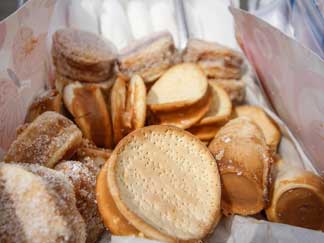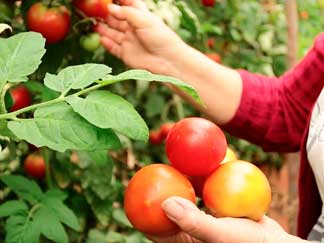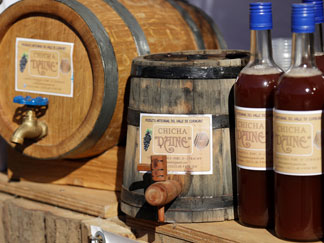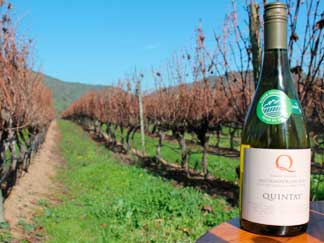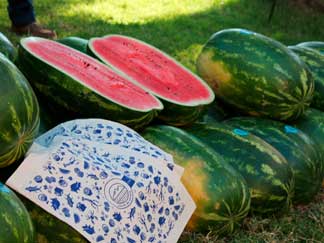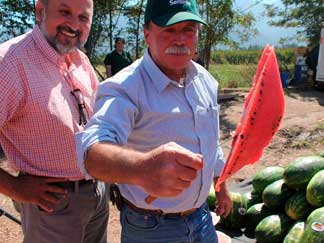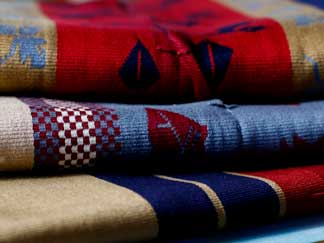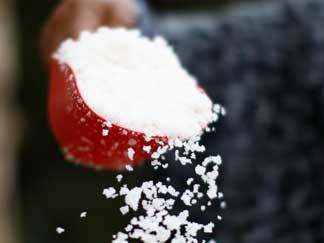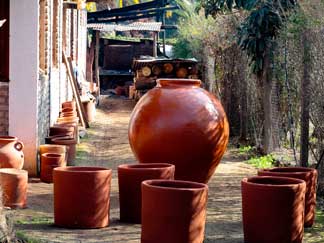Manos de Isla Negra / Manos de Isla Negra
- Applicant: El Quisco Municipality
- Location: Casablanca

This certification mark was granted in order to distinguish fabric and textile products created by the wives of farmers and fishermen of Isla Negra, who have become internationally renowned artists whose achievements have set a landmark in Latin American art.
Dulces de La Ligua / La Ligua pastries
- Applicant: Asociación Gremial de fabricantes de Dulces de La Ligue A.G.
- Location: La Ligua
- E-mail: davidplaza27@hotmail.com

The city of La Ligua is located 150 km from Santiago and 110 km from Valparaíso. In colonial times, one of the primary means of livelihood was gold mining, replaced at the start of the 20th century by textile arts and confectionery, with both becoming part of the city’s identity.
There are two versions of the origin story of the La Ligua pastries. The first claims that the pastries probably arose from colonial confectionery traditions, imported by Augustinian nuns from Spain, who had been producing and selling pastries using recipes that allowed for prolonged preservation, in order to raise money for their religious order. The second version attributes the confectionery tradition to families who emigrated from Copiapó to the city at the end of the 19th century, spurred by the economic crisis resulting from the depletion of mineral deposits in the northern city (Source: Technical report for the appellation of origin registration of La Ligua pastries, Application No. 1058439).
Sabor Limachino / Sabor Limachino
- Applicant: Limache Municipality
- Location: Limache

The Limache tomato has for a long time been one of the characteristic products of the Limache basin and the Valparaíso region in general, with an unrivalled flavor and aroma. Its origins can be traced back to a mixture of Genoese and French seeds, brought by Italian immigrants, which were successfully cultivated by farmers in the area. However, being a product with a short shelf life, it was replaced in markets and supermarkets by longer-lived tomatoes. The “Sabor Limachino” mark certifies that the tomatoes have been planted and harvested in the Limache commune. It also certifies the aspects that represent and distinguish the product, from the beginning of the production process to its sale, subject to quality standards established in its usage regulations.
Download list of producers
Chicha de Curacaví / Curacaví Chicha
- Applicant: Association of Producers of Chicha de Curacaví

This is a grape chicha produced in Curacaví, whose main characteristic is that it is cooked in pots with a copper base and made with Vitis Vinífera grapes. It does not contain any other ingredients, whether natural or artificial. The crushing process is artisanal. The average alcohol content of the chicha is 7.06% v/v, the average acidity is 3.44 g/l, and the color index is 10.42.
Download list of producers
Dulces de Curacaví / Curacaví pastries
- Applicant: Metropolitan Regional Government

Curacaví pastries are oven-baked and mainly filled with manjar or dulce de leche. Depending on how they are prepared, they can be classified as any of 12 kinds of pastries: chilenitos, alfajores, príncipes, empolvados, cocadas, merengues, alcayota and pear empanaditas, mil hojas, bizcochos or tortas, tacitas, hojas, or huevo mol. The geographical zone corresponds to Curacaví commune, Melipilla province, Metropolitan region.
Download list of producers
Viñedos Casablanca Route / Casablanca Route Vineyards
- Applicant: Association of Wine Entrepreneurs of Casablanca
- Location: Casablanca

Collective mark used to distinguish wine products produced in the Casablanca commune, from vines produced in the Casablanca commune and whose characteristics or reputation are mainly attributable to their shared origin in the protected geographical area.
Sandía de Paine / Paine Watermelon
- Applicant: Paine Municipality

The Paine Commune is located in the Metropolitan Region, in the Maipo Province, characterized mainly by its agrarian culture.
The watermelon (Citrullus lanatus thunb) is an annual, herbaceous plant, belonging to the gourd family. The rind can be flat-colored, with variable tones ranging from dark green to light green, or have bands of a light green color on a dark background.
The watermelons of Paine are known their intense sweetness and nutritional qualities, standing out from watermelons produced elsewhere because of their long tradition and the reputation they have gained over the years.
Download list of producers
Corazón de Paine / Corazón de Paine
- Applicant: Paine Municipality
- Location: Avenida General Baquedano 502, Paine, Metropolitan Region

The Paine commune is located in the Metropolitan region, in the Maipo province, characterized mainly by its agrarian culture.
Producers belonging to the Paine Watermelon Trade Association are authorized to use the Corazón de Paine collective mark for watermelons destined for the national market or for exportation if their production processes are in keeping with the following regulations:
The watermelons must be grown and harvested in the Paine Commune, and must be of the quality and condition specified further ahead. Watermelons which are unripe, bruised, defective, overripe, or do not meet the minimum size requirements cannot be sold.
The producer must use safe production processes that guarantee meeting the required environmental and labor standards.
The producer must guarantee its participation in decision-making, coordination with points of sale, the sharing of information on the correct usage of the Corazón de Paine collective mark, the sharing of information on possible terrain for fruit production, critical stages in the production, (lack of) pesticide residues, creating harvesting forecasts, and determining the appropriate time for harvests.
The watermelon must:
a. Be harvested between November each year and March the next year.
b. Be homogeneous and consistent in its quality and condition during the entire season, taking into account color, size, shape, among other characteristics.
c. Look pleasant on the inside.
d. Be firm and not rotten.
e. Be whole, healthy, clean, firm, and sufficiently ripe, with the taste and color corresponding to the degree of ripeness; the fruit cannot be burst, bruised, foul-smelling, deformed, perforated, sunburnt, damaged by animals, or have an odd taste; there should be no trace of impurity or other damages in the surface, withstanding transportation and handling, arriving in a satisfactory condition to the destination.
f. Watermelons from other communes must not be bought and the collective mark Corazón de Paine placed on them.
g. Watermelons can be bought from associated producers in the Paine Commune and the Corazón de Paine collective mark placed on them, with approval from the board of the Paine Watermelon Trade Association.
h. Producers not associated with the Paine Watermelon Trade Association may not use the Corazón de Paine collective mark.
i. The collective mark can only be used for watermelons belonging to the following categories or sizes: Super extra, extra, first, and second, whose parameters are established by the Paine Watermelon Trade Association each season.
Download list of producers
Chamantos y mantas corraleras de Doñihue / Doñihue Chamantos and Mantas Corraleras
- Applicant: Grouping Chamanteras de Doñihue
- Location: Emilio Cuevas 626, Doñihue
- E-mail: filomenacantillana@hotmail.com
- Contact telephone: +56 2 2462344

The Doñihue commune is found in Cachapoal province, 22 km from Rancagua, capital of the Libertador Bernardo O’Higgins region.
One of the characteristic trades of Doñihue is the textile tradition of chamanto-making, the iconic dress of the Chilean huaso, used especially in celebrations, festivities, and rodeos.
The chamanto is essentially a square or rectangular cloth with a hole in the middle for the head and draped around the shoulders, used to provide protection from inclement weather. The difference between the chamanto and the manta corralera is that the former incorporates figures known as labores in its design, while the manta is adorned only with lines of different colors.
This information comes from the technical report justifying the granting of appellation of origin to Doñihue chamantos and mantas corraleras.
Download list of producers
Sal de Cáhuil - Boyeruca Lo Valdivia / Cahuil Salt - Boyeruca Lo Valdivia
- Applicant: Region of O'Higgins

The salt pans of Cahuil and Boyeruca are found between the southern side of the O’Higgins Region and the northern side of the Maule Region. Their use is presumed to date to prehispanic times. Since then, the salt pans have enjoyed a long history, parallel to the history of Chile itself, constituting a heritage combining social, economic, and mining industry factors.
The salt has a white, gray, or occasionally slightly pink or yellow hue, is odorless, does not form lumps, is easy on the palate, and dissolves easily when seasoning different foods.
The salt producers of the area possess an empirical knowledge, gathered through the craft they have been practicing for generations, that allows them to maintain the qualities of the salt they produce intact, such as allowing water to flow in order to avoid the concentration of undesired elements.
Download list of producers
Alfarería de Pomaire / Pumaire pottery
- Applicant: Grouping of Artesanos Pomaire
- Location: Pomaire

Pomaire is a small village in the Melipilla commune, 70 km to the west of Santiago. It is located to one side of the La Cruz mountain clay pit, giving rise to a nascent pottery industry during colonial times, providing functional objects to Spanish landowners and ranchers of the time.
It was in those artisanal workshops where the first large fired clay vessels that are still a part of rural Chilean tradition were made, being at the time indispensable containers for seeds, chicha, and wine. Although the craft has been passed down from generation to generation, it was in 1930 when large changes in the production process were introduced, such as the incorporation of kilns, foot-powered lathes, and clay mills into the process.
Today, the Pomaire pottery industry has forged its own identity, becoming one of the most recognizable artesanal products of our country.
Loza de Pilén / Pilén Earthenware
- Applicant: Producer contact info

Utilitarian and decorative clay pottery made following a centuries-long tradition in Pilén, located 15 km from Cauquenes, Maule Region. The pottery has a uniformly reddish finish due to the local application of engobe, achieved by burning and smoking the pottery using firewood and/or guano once the piece is finished and fired. It can also be blackened by enveloping the hot pieces with dry leaves, immediately after they are fired. Formally, the pieces are classified according to three categories: open, closed, and sculptural.
Download list of producers









